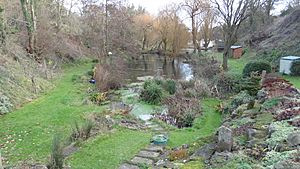Letcombe Brook facts for kids
Letcombe Brook is a lovely stream, about 7.5-mile (12 km) long, found in Oxfordshire, England. It starts at the bottom of the Berkshire Downs hills in a village called Letcombe Bassett. From there, it flows through several towns and villages like Letcombe Regis, Wantage, Grove, and East Hanney. Eventually, it joins another stream called Childrey Brook. Childrey Brook then flows into the River Ock, which is a smaller river that joins the mighty River Thames. So, Letcombe Brook is part of a big family of waterways!
Contents
Discovering Letcombe Brook
Letcombe Brook is special because it's a type of river called a chalk stream. These streams are very rare around the world. They get their water from underground springs that flow through chalk rock. This makes the water super clear and cool, which is perfect for certain plants and animals.
What Makes a Chalk Stream Special?
Chalk streams are like nature's hidden gems. They are fed by pure, filtered water that has traveled through chalk bedrock. This process keeps the water at a steady, cool temperature all year round. It also means the water is rich in minerals, which helps unique plants and insects to grow. Because they are so rare, protecting chalk streams like Letcombe Brook is really important.
Amazing Wildlife of the Brook
Even though it's a small stream, Letcombe Brook is home to lots of different animals. Its clean, cool water provides a perfect habitat for many creatures.
Protected Species in the Brook
Some of the animals living in Letcombe Brook are considered "protected species." This means they are rare or at risk, and special laws are in place to keep them safe.
- Water Voles: These furry, hamster-like creatures love to live near water. They dig burrows in the banks of the stream and are excellent swimmers. Water voles are sadly becoming rare in many parts of the UK, so finding them in Letcombe Brook is a great sign!
- Bullheads: These are small, bottom-dwelling fish with large heads. They like to hide among stones and plants at the bottom of the stream. Bullheads are a good sign of clean, healthy water.
- Brook Lampreys: These are ancient, eel-like fish that don't have jaws. They spend most of their lives as larvae buried in the stream bed, filtering food from the water. When they become adults, they don't feed and only live long enough to reproduce. Their presence shows the brook has a healthy ecosystem.
Protecting the Brook
Over the years, things like new buildings, farming, and people using a lot of water have sometimes made the brook's habitats less healthy. However, thanks to hard work, the water in Letcombe Brook is now much cleaner than it used to be. This cleaner water helps all the amazing wildlife thrive.
The Letcombe Brook Charitable Trust
A special group called the Letcombe Brook Charitable Trust was set up to help protect the brook. This trust was created to honor a famous poet named Sir John Betjeman. He lived near the brook for many years and loved the area. In 1972, when he became the official Poet Laureate (a special poet chosen by the King or Queen), he wrote a poem called "On Leaving Wantage." It starts with a line about the brook: "I like the ways these old brick garden walls run unevenly down to Letcombe Brook." This shows how much the brook meant to him.
Letcombe Valley Nature Reserve
Part of the brook flows through the Letcombe Valley, which is a nature reserve. It's about 7.5 hectares (that's like 18 football fields!) and was opened in 2010. The Berkshire, Buckinghamshire and Oxfordshire Wildlife Trust helps manage this area. They were given a long-term lease and money to make sure the valley stays a wonderful place for wildlife and for people to enjoy nature.


